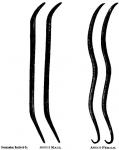 Synonym.—Ascaris Lumbricoides (long round worm).
Synonym.—Ascaris Lumbricoides (long round worm).
Natural History.—This is found more frequently than any of the intestinal parasites, and though seen at any time of life, occurs most frequently in children under ten years of age.
It resembles the common earth or angle worm, is cylindrical, pointed at both ends; head slightly incurvated with a transverse contracture beneath it; mouth triangular; body transparent; color, light yellow or reddish, with a faint line down the side; gregarious, viviparous; from six to fifteen inches long in the female, and from four to eight inches in the male.
It inhabits principally the ileum, but sometimes ascends into the stomach, and may creep out of the mouth and nostrils, or it may enter the trachea through the larynx. The hepatic ducts have been invaded, followed by abscesses, and cases have been reported where they have ascended the Eustachian tube, penetrating the tympanic membrane. Not infrequently they travel to the rectum and pass away at the anus.
Symptoms.—The child is generally poorly nourished, has a capricious appetite; the tongue is loaded with a moist, yellowish, dirty coating; there is an offensive breath and enfeebled digestion. The child is restless at night, tossing in his sleep, grits his teeth, starts in his sleep, frequently awakening in a fright. There is often seen a white ring around the mouth, and the child frequently picks its nose. In the afternoon the cheeks become flushed, and a slight fever makes its appearance.
While the above symptoms are usually regarded as pathognomonic, they may all be present and no parasites found, or they may all be absent and the child pass worms, the only positive "signs" being the passage of the parasites, which may be by way of the bowel or during a paroxysm of coughing.
A little patient of mine, suffering with whooping-cough, during a paroxysm of coughing, vomited freely, expelling three large worms, eight, ten, and twelve inches long, respectively, there being no suspicion of worms before their expulsion.
Complications.—The most serious complication will be obstruction of the bile-ducts, and would be recognized by jaundice and impaired digestion. Intestinal obstruction from impacted parasites has occurred.
Diagnosis.—This can only be positively determined by the discovery of the parasites in the stool, or by their being vomited, or crawling from the mouth.
Prognosis.—It is generally favorable, though should they penetrate the bile-ducts, fatal results would most likely follow.
Treatment.—The treatment will not only consist in removing the parasites, but also in improving the general health, so as to render the soil "sterile," for parasites will not inhabit a healthy intestinal canal.
Fortunately we have a specific in santonin, and as this remedy is the least disagreeable of the many anthelmintics, it is the one most universally given. To get the best results, the agent should be administered on an empty stomach, and so is given before each meal, the child being placed on a light diet for forty-eight hours, and not allowed to "piece" between meals. I usually give, of the first trituration, about as much as will lie on a dime, three times a day. In addition the child should have a dose of sulphur twice a week for several weeks.
Spigelia is another specific for the removal of the round worm. A not unpleasant and efficient vermifuge is the following:
| Fluid Extract of Spigelia | 1 - 2 drams. |
| Powdered Santonin | 15 grains. |
| Simple Syrup | 3 ounces. |
| Essence Peppermint | 10 drops. M. |
Sig. Teaspoonful before each meal.
The bottle should be well shaken before each dose is given, as the santonin will not dissolve in the above vehicle. A laxative should be given the third day of the treatment.
After the removal of the parasites, treatment should be continued to bring about a better condition of the digestive tract and to improving the general health. A bitter tonic, plenty of fresh air, a nutritious diet, and the restriction of overindulgence in candy and sweetmeats, will give the best results.
The Eclectic Practice of Medicine, 1907, was written by Rolla L. Thomas, M. S., M. D.

